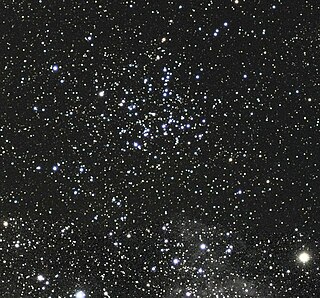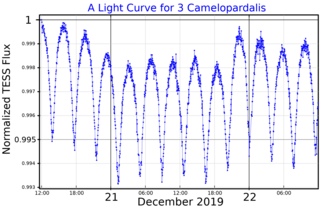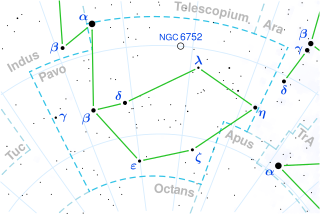
Beta Lyrae officially named Sheliak, the traditional name of the system, is a multiple star system in the constellation of Lyra. Based on parallax measurements obtained during the Hipparcos mission, it is approximately 960 light-years distant from the Sun.

9 Aurigae is a star system in Auriga (constellation). It has an apparent magnitude of about 5, making it visible to the naked eye in many suburban skies. Parallax estimates made by the Hipparcos spacecraft put it at about 86 light-years from the solar system, although individual Gaia Data Release 3 parallaxes place all three components at 88 light years.

1 Vulpeculae is a class B4IV star in the constellation Vulpecula. Its apparent magnitude is 4.77 and it is approximately 780 light years away based on parallax.

9 Vulpeculae is a star in the northern constellation of Vulpecula, located about 560 light years away based on parallax. It is visible to the naked eye as a faint, blue-white hued star with a baseline apparent visual magnitude of 5.01. The star is moving further from the Earth with a heliocentric radial velocity of +5 km/s.

IC 2391 is an open cluster in the constellation Vela consisting of hot, young, blueish stars, some of which binaries and one of which is a quadruple. Persian astronomer A. a.-R. Al Sufi first described it as "a nebulous star" in c. 964. It was re-found by Abbe Lacaille and cataloged as Lac II 5.
HD 115404 is a binary star system located in the constellation Coma Berenices. Parallax measurements made by Hipparcos put the system at 36 light-years, or 11 parsecs, away. The combined apparent magnitude of the system is 6.52, with the magnitudes of the components being 6.66 and 9.50.
HD 224635 and HD 224636 is a pair of stars comprising a binary star system in the constellation Andromeda. They are located approximately 94 light years away and they orbit each other every 717 years.
HD 1185 is a double star in the northern constellation of Andromeda. The primary, with an apparent magnitude of 6.15, is a white main-sequence star of spectral type A2VpSi, indicating it has stronger silicon absorption lines than usual, thus making it also an Ap star. The secondary companion, which is 9.08 arcseconds away, is not visible to the naked eye at an apparent magnitude of 9.76. It shares common proper motion and parallax with the primary star but orbital parameters are still unknown.

LY Aurigae is a multiple star system in the constellation Auriga. It is an eclipsing binary variable star, dropping in brightness by 0.7 magnitudes every 4 days. The system is around a thousand light years away in the Auriga OB1 stellar association.

Alpha Microscopii (α Microscopii) is a star in the southern constellation of Microscopium. It is visible to the naked eye with an apparent visual magnitude of 4.89. Based upon an annual parallax shift of 8.2508 mas as seen from the Earth, it is located 395 light years from the Sun, give or take 7 light years. The star is moving nearer to the Sun with a heliocentric radial velocity of −15 km/s
HD 135438 is a K-type giant star in the northern constellation of Boötes. With an apparent magnitude of 6.0, it lies about 650 light years away.
HD 112028 is an evolved star in the northern constellation of Camelopardalis. It has spectral peculiarities that have been interpreted as a shell, and also relatively weak magnesium and silicon lines. Its spectral class has been variously assigned between B9 and A2, and its luminosity class between a subgiant and bright giant.

3 Camelopardalis is a spectroscopic and visual binary in the constellation Camelopardalis. It is approximately 496 light years from Earth.
HD 107914 is the primary component of a binary star system in the constellation Centaurus, with an estimated distance of 255.5 light-years (78.3 pc) from the Solar System. It has a stellar classification of A7-8 III, making it a giant star.

ξ Pavonis, Latinised as Xi Pavonis, is a triple star system in the southern constellation of Pavo. It is visible to the naked eye as a faint star with a combined apparent visual magnitude of 4.35 The system is located approximately 440 light-years from the Sun based on parallax, and it is drifting further away with a radial velocity of +12 km/s.

QZ Puppis is a class B2.5V star in the constellation Puppis. Its apparent magnitude is 4.5 and it is approximately 650 light years away based on parallax.

1 Puppis is a single star in the southern constellation of Puppis. It lies in the northern part of the constellation at a distance of about 790 ly, east of Aludra in Canis Major and just north of the white supergiant, 3 Puppis. This object is visible to the naked eye as a faint, red-hued star with an apparent visual magnitude of 4.59. It is moving further from the Earth with a heliocentric radial velocity of +32.4 km/s.

HD 15558 is a massive O-type multiple star system in Cassiopeia and is specifically in our galaxy's Heart Nebula in the open cluster IC 1805. The primary is a very massive star with 152 M☉ and 660,000 L☉.

HD 1, also known as HIP 422, is the first star catalogued in the Henry Draper Catalogue. It is located in the northern circumpolar constellation Cepheus and has an apparent magnitude of 7.42, making it readily visible in binoculars, but not to the naked eye. The object is located relatively far away at a distance of 1,220 light years but is approaching the Solar System with a spectroscopic radial velocity of −27.3 km/s.
7 Tauri is a multiple star in the northern constellation of Taurus. It has a combined apparent visual magnitude of 5.95, so, according to the Bortle scale, it is faintly visible from suburban skies at night. Measurements made with the Gaia spacecraft show an annual parallax shift of 5.5 mas, which is equivalent to a distance of around 593 light years from the Sun.











